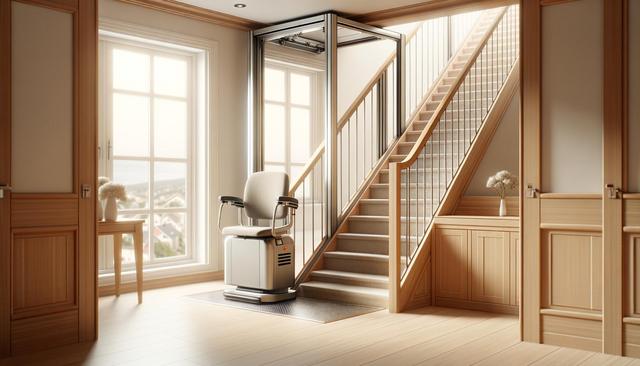Understanding What a Stair Lift Is
A stair lift is a motorized chair that travels along a rail mounted to a staircase, allowing individuals to move safely between floors. Often used by people with limited mobility due to age, injury, or disability, stair lifts provide a practical solution for remaining independent in multi-level homes. They are commonly installed in residential settings but can also be found in some public buildings where accessibility is a concern. The design typically includes a seat, armrests, a footrest, and safety features such as seat belts and obstruction sensors, ensuring a secure and comfortable ride.
Stair lifts are available in two main types: straight and curved. Straight stair lifts are designed for staircases without any turns or landings, while curved models are custom-built to fit staircases that bend or change direction. This distinction ensures that a wide variety of home layouts can be accommodated. Additionally, modern stair lifts often come with remote controls, foldable components for space-saving, and battery-powered options to function during power outages.
Who Can Benefit from a Stair Lift?
Stair lifts can be life-changing for a broad range of individuals. Most commonly, they are used by senior citizens who wish to age in place, avoiding the need to move to a single-story home or assisted living facility. However, their benefits extend beyond the elderly. People recovering from surgery, individuals with chronic conditions like arthritis or multiple sclerosis, and those with temporary mobility issues can all find value in a stair lift.
Key groups who may find stair lifts especially useful include:
- Older adults experiencing reduced balance or strength
- Individuals with mobility-reducing medical conditions
- Post-operative patients needing short-term assistance
- Caregivers seeking safer options for assisting family members
With the ability to reduce the risk of falls and eliminate the physical strain of climbing stairs, stair lifts contribute not just to safety but also to peace of mind for users and their families.
Important Features to Consider
When selecting a stair lift, it’s important to understand which features align with the user’s needs and the home’s layout. Safety is a top priority, and most stair lifts come equipped with essential safety elements. However, optional features can enhance the experience further. These include swivel seats for easier boarding and disembarking, adjustable seat heights, and call/send controls that allow the lift to be summoned from either end of the staircase.
Here are a few other features to look for:
- Foldable footrests and seats to maintain stairway access
- Quiet operation for minimal disruption
- Emergency stop and obstruction sensors
- Battery backup for continued use during power outages
Additionally, the material and design of the stair lift should complement the home’s interior. Some models offer customization options such as fabric choices and rail colors, helping the lift blend in aesthetically.
Installation and Maintenance
Installing a stair lift generally involves a straightforward process, especially for straight staircases. In most cases, the lift is mounted directly to the staircase rather than the wall, which means there’s minimal structural impact. Professional installation is typically recommended to ensure the lift is safely and securely fitted. The timeline for installation can vary depending on the stair lift type. While straight models can often be installed in a few hours, custom curved versions may take longer due to the need for precise measurements and manufacturing.
Regular maintenance is important to keep a stair lift functioning reliably. Most manufacturers suggest annual servicing, which includes checking the motor, rail system, and safety features. Homeowners can also perform simple tasks like keeping the rail clean and ensuring the seat folds properly. Many stair lifts come with warranties and service plans, which can provide added peace of mind.
Cost and Accessibility Options
The cost of a stair lift can vary significantly depending on the type, features, and customization required. Straight stair lifts tend to be more affordable, while curved models are more costly due to the custom design involved. Additional features can also affect the overall price. It’s worth noting that some health insurance plans or local assistance programs may offer financial support for stair lift installation, particularly when medically necessary.
For those with budget concerns, several options can make stair lifts more accessible:
- Rental options for short-term use
- Refurbished or second-hand models
- Financing plans offered by providers
- Grants or funding from mobility organizations or local governments
Investing in a stair lift is ultimately about enhancing quality of life. While the upfront cost may be a consideration, the long-term benefits in terms of safety, independence, and convenience often outweigh the initial expense.
Conclusion: Supporting Independent Living
Stair lifts offer a reliable and practical solution for individuals who face challenges with stairs but wish to remain in their multi-level homes. By improving accessibility and reducing the risk of falls, they support safer and more independent living. Whether for long-term use or temporary recovery, stair lifts can bring peace of mind not just to users, but also to their families and caregivers. Taking the time to explore the right features, installation options, and financial assistance can help ensure a smooth transition to a more accessible home environment.



Leave a Reply